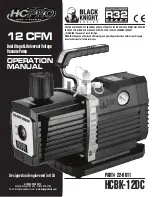
29
Connecting the primary circuit
!
Please note
The heat transfer medium can cause corrosion
damage to on-site lines and components.
The components and lines used must be resist-
ant to the heat transfer medium. Never use zinc-
plated/galvanised pipes.
1.
Equip the primary circuit with an expansion vessel
and safety valve (in accordance with DIN 4757).
Note
■
The expansion vessel must be approved to
DIN 4807. Diaphragms of the expansion vessel
and safety valve must be suitable for the heat
transfer medium.
■
Discharge and drain pipes must terminate in a
container that can hold the maximum possible
expansion volume of the heat transfer medium.
2.
Ensure adequate thermal and anti-vibration insula-
tion of all pipes routed through walls.
3.
Connect primary pipes to heat pump.
!
Please note
Mechanically loaded hydraulic connections
lead to leaks, vibration and appliance dam-
age.
Connect on-site lines so that they are free of
load and torque stress.
!
Please note
If the casing is not carefully closed, damage
from condensation may occur.
■
With line entries, ensure the diaphragm
grommets on the l.h. side panel are seated
correctly.
■
Make line entries airtight.
4.
Insulate primary lines inside the building with ther-
mally insulating and vapour diffusion-proof materi-
als.
5.
Charge the primary circuit with Viessmann heat
transfer medium and vent.
Connecting the secondary circuit
1.
Equip the secondary circuit on site with an expan-
sion vessel and safety assembly (in accordance
with DIN 4757).
Fit the safety assembly to the on-site line in the
heating water return.
2.
Connect secondary lines to the heat pump.
!
Please note
Mechanically loaded hydraulic connections
lead to leaks, vibration and appliance dam-
age.
Connect on-site lines so that they are free of
load and torque stress.
!
Please note
If the casing is not carefully closed, damage
from condensation may occur.
■
With line entries, ensure the diaphragm
grommets on the l.h. side panel are seated
correctly.
■
Make line entries airtight.
3.
Fill and vent the secondary circuit in line with VDI
2035.
4.
Thermally insulate pipes inside the building.
Note
■
In underfloor heating circuits, install a temperature
limiter on site to restrict the maximum temperature of
the underfloor heating system.
■
Ensure the minimum flow rate, e.g. by means of an
overflow valve (see "Specification" from page 80).
Installation sequence
Making the hydraulic connections
(cont.)
5787 232 GB
Installation
Summary of Contents for BW 301.C090
Page 91: ...91 5787 232 GB...
















































